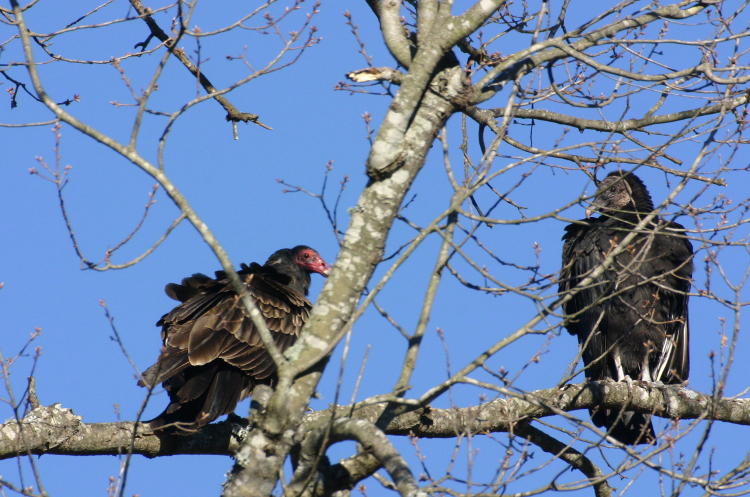
Today’s feature comes from 2013, and is somewhat appropriate because these two are waiting to feast on the decaying remains of the blog.
Okay, it’s not that bad – it’s just a typical winter slump, and overall a bad time to chase photos for myriad reasons, free time, weather, and fighting to get over a sinus infection among them. But in comparison, I already have more posts for this month than the month this was actually taken, so I’m not going to feel too bad about it. What we have here are a turkey vulture (Cathartes aura) on the left, and a black vulture (Coragyps atratus) on the right; same Family, which is Cathartidae, but different Genus between them. That said, there’s the more obvious appearance difference when seen perched like here, but other details that are more visible when aloft, since the heads become very hard to distinguish at any distance. The turkey vultures have silvery-grey undersides to their flight feathers, which amounts to the ‘trailing edge’ or back half of the wings, while the black vultures have such brighter coloration only on the six feathers at the wingtips, giving them a pale ‘palm.’ Also, the turkey vulture has a more distinct tail that the black, with a visible length in contrast to the little rounded ‘bump’ of the black vulture’s tail. Once you get used to seeing the differences, they’re obvious at the first good ventral view.
I’m almost certain these were perched in a tree not far from the old house, hanging out as the thermals died down. Vultures are soarers – obviously, because that’s how we all know them, wheeling in circles with little or no flapping – and they count on strong updrafts to help them fly without expending much energy. When the day isn’t gusty or producing updrafts, they more often simply maintain a perch and conserve energy until things change. I took the opportunity when I spotted these to record the visible differences between the two species, up close anyway – I can’t recall if I have both species in the same frame in flight, so you could see the wing and tail distinctions, but I suspect not. Maybe someday.
One more thing while we’re here, and I think I’ve mentioned this before but this topic can never be repeated enough. I used to rehabilitate injured raptors, and while most of the hawks and owls presented formidable opposition to handling with both their beaks and their talons, vultures tended not to wield either in this manner; their beaks were sharp enough but they simply had the habits and inclination to use those sharp edges only on dead things. However, their defense method was in many ways much more dire, because a threatened vulture will vomit on its foe, and this is just as horrendous as you imagine it, if not worse. I had a seasoned animal health tech apologize quickly and flee the room when it occurred, even though I’d recognized the hurking gestures from the vulture in my grasp and aimed its head towards the trash can. Thankfully, my rehab trainers had adequately warned me about such fates and I never got directly ‘assaulted’ in this manner, but still, the aroma of regurgitated carrion is not exactly piquant. One out of five stars; cannot recommend.



















































